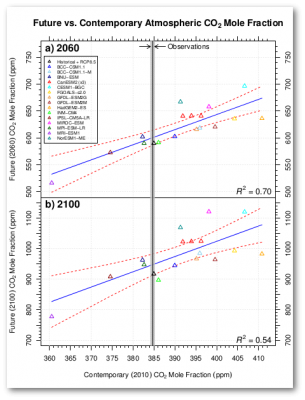Causes and Implications of Persistent Atmospheric Carbon Dioxide Biases in ESMs
We compared CMIP5 Earth system model projections of atmospheric carbon dioxide and carbon reserveroirs with observations and removed contemporary biases to estimate future atmospheric carbon dioxide levels.
An emergent constraint based on carbon inventories was applied to constrain future atmsopheric CO2 projections from CMIP5 ESMs.
- Much of the model-to-model variation in projected CO2 during the 21st century is tied to biases that existed during the observational era.
- Model differences in the representation of concetration–carbon feedbacks and other slowly changing carbon cycle processes appear to be the primary driver of this variability.
- Range of temperature increases at 2100 slightly reduced, from 5.1 ± 2.2°C for the full ensemble, to 5.0 ± 1.9°C after applying the emergent constraint.
The authors wish to thank R. J. Stouffer for his thoughtful comments on an early draft of the paper, which lead to improvements in the discussion of our results. In addition, the authors gratefully acknowledge the careful reviews of T. A. Boden, R. J. Norby, and S. Denning. This research was sponsored by the Earth and Environmental Systems Sciences Division (EESSD) of the Biological and Environmental Research (BER) Program in the U. S. Department of Energy Office of Science and the National Science Foundation (AGS-1048890). This research used resources of the National Center for Computational Sciences (NCCS) at Oak Ridge National Laboratory (ORNL), which is managed by UT-Battelle, LLC, for the U. S. Department of Energy under contract DE-AC05-00OR22725. CDJ was supported by the Joint DECC/Defra Met Office Hadley Center Climate Program (GA01101). This is a contribution to the BIOFEEDBACK project of the Center for Climate Dynamics (SKD) at the Bjerknes Center for Climate Research. The National Center for Atmospheric Research is sponsored by the National Science Foundation. We acknowledge the World Climate Research Program's Working Group on Coupled Modeling, which is responsible for CMIP, and we thank the climate modeling groups (listed in Table 1 of this paper) for producing and making available their model output. For CMIP, the U. S. Department of Energy's Program for Climate Model Diagnosis and Intercomparison provides coordinating support and led development of software infrastructure in partnership with the Global Organization for Earth System Science Portals.

